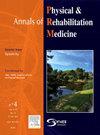Significant immediate and limited long-term benefit of prism adaptation on spatial neglect: a systematic review and meta-analysis of RCTs
IF 4.6
3区 医学
Q1 REHABILITATION
Annals of Physical and Rehabilitation Medicine
Pub Date : 2025-09-18
DOI:10.1016/j.rehab.2025.102022
引用次数: 0
Abstract
Background
Although prism adaptation (PA) has been applied in spatial neglect (SN) for 27 years, its efficacy remains controversial and lacks consistency.
Objective
The first aim was to assess the immediate and long-term effects of PA on SN via meta-analysis of randomized controlled trials (RCTs). The second aim was to identify potential effect modifiers of PA efficacy.
Methods
We searched four databases up to March 2025 for RCTs comparing PA, or PA+conventional vs. shamPA, or shamPA+conventional, or only conventional in participants with SN, and assessing behavioral or neuropsychological tests (such as Catherine Bergego scale (CBS) and behavioral inattention test (BIT)). Cochrane risk-of-bias assessment tool and random-effects meta-analysis were used, and effect size was reported as Weighted Mean Difference (WMD) with 95 % CI.
Results
Only 10 RCTs (356 participants) could be included, eight of them reporting CBS data and six for BIT. Immediate PA effects on SN showed a significant improvement for CBS between the PA group (PA/PA+conventional) and control group (shamPA/ shamPA+conventional/only conventional), all studies with prism shift ≥10°, (WMD = −2.13, 95% CI −3.93 to 0.33; P = 0.020), but non-significance for conventional BIT (BIT-C). Long-term benefit was not significant for CBS, while it was significant for BIT-C when the prism shift was ≥10° (n = 2; WMD = 12.37, 95% CI 0.53 to 24.21; P = 0.041). Linear regressions showed non-significant effect modifiers among the participant characteristics or PA intervention parameters. Subgroup analyses for CBS showed a significant immediate improvement in the larger total quantity of prism exposure (number of total trials × prism shift) subgroup (WMD = −2.73, 95% CI −5.01 to −0.44; P = 0.019), whereas the subgroup with smaller total exposure showed no significant difference.
Conclusion
Even with stringent inclusion criteria, significant effects of PA on SN were observed in the short-term CBS (all studies with prism shift ≥10°), mainly derived from studies with total exposure ≥11250°·trials. The total quantity of prism exposure (°·trials) may be an applicable effect modifier of PA efficacy.
Trial Registration
PROSPERO database (registration number: CRD420250650402).
棱镜适应对空间忽视的直接和有限的长期效益:随机对照试验的系统回顾和荟萃分析。
背景:棱镜自适应(prism adaptation, PA)在空间忽视(spatial neglect, SN)中的应用已有27年,但其有效性仍存在争议,且缺乏一致性。目的:第一个目的是通过随机对照试验(rct)的荟萃分析来评估PA对SN的近期和长期影响。第二个目的是确定PA疗效的潜在效果调节剂。方法:我们检索了截至2025年3月的4个数据库,检索了在SN患者中比较PA、PA+常规与shamPA、shamPA+常规或仅常规的随机对照试验,以及评估行为或神经心理测试(如Catherine Bergego量表(CBS)和行为注意力不集中测试(BIT))的随机对照试验。使用Cochrane偏倚风险评估工具和随机效应荟萃分析,效应大小报告为加权平均差(WMD), 95% CI。结果:仅纳入10项rct(356名受试者),其中8项报告CBS数据,6项报告BIT数据。即刻PA对SN的影响在PA组(PA/PA+常规)和对照组(shamPA/ shamPA+常规/仅常规)之间的CBS均有显著改善,所有研究中棱柱移位≥10°(WMD = -2.13, 95% CI = -3.93 ~ 0.33; P = 0.020),但对常规BIT (BIT- c)无显著性影响。CBS的长期获益不显著,而BIT-C在棱镜移位≥10°时显著(n = 2; WMD = 12.37, 95% CI 0.53 ~ 24.21; P = 0.041)。线性回归显示受试者特征或PA干预参数的影响不显著。CBS的亚组分析显示,较大的棱镜总曝光量(总试验数×棱镜位移)亚组(WMD = -2.73, 95% CI -5.01 ~ -0.44; P = 0.019)立即显著改善,而较小的总曝光亚组无显著差异。结论:即使采用严格的纳入标准,在短期CBS(所有棱镜移位≥10°的研究)中仍观察到PA对SN的显著影响,主要来源于总暴露≥11250°·试验的研究。棱镜总曝光量(°·试验)可能是一种适用于PA疗效的效果调节剂。试验注册:PROSPERO数据库(注册号:CRD420250650402)。
本文章由计算机程序翻译,如有差异,请以英文原文为准。
求助全文
约1分钟内获得全文
求助全文
来源期刊

Annals of Physical and Rehabilitation Medicine
Medicine-Rehabilitation
CiteScore
7.80
自引率
4.30%
发文量
136
审稿时长
34 days
期刊介绍:
Annals of Physical and Rehabilitation Medicine covers all areas of Rehabilitation and Physical Medicine; such as: methods of evaluation of motor, sensory, cognitive and visceral impairments; acute and chronic musculoskeletal disorders and pain; disabilities in adult and children ; processes of rehabilitation in orthopaedic, rhumatological, neurological, cardiovascular, pulmonary and urological diseases.
 求助内容:
求助内容: 应助结果提醒方式:
应助结果提醒方式:


